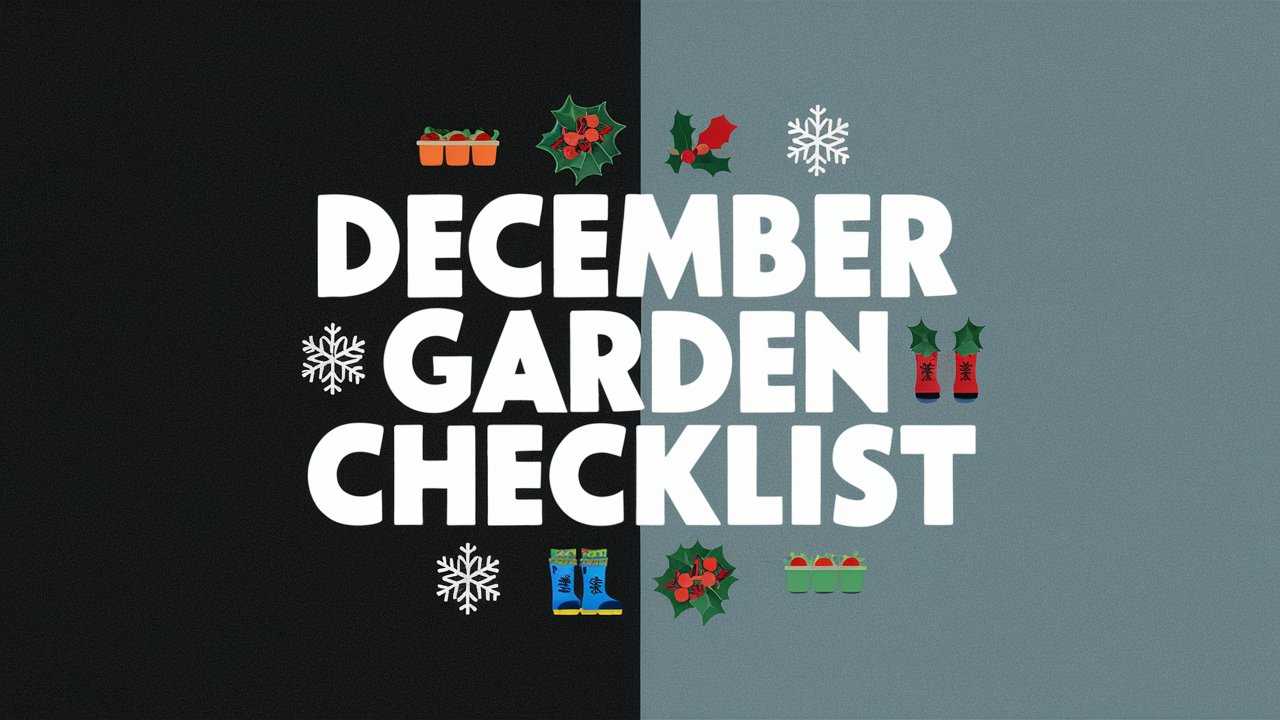As December rolls around, many gardeners may think it’s time to put their gardening tools away and wait for spring. However, December is a crucial month for gardening, especially for those in temperate climates.
While the garden may appear dormant, there are many important tasks to undertake to ensure that your garden is ready for winter and prepared for the early spring.
This post will provide a comprehensive checklist to guide you through these essential tasks, making sure your garden thrives when the warmer weather returns.
1.Protect Your Plants
Mulching
Applying a layer of mulch around your plants is a great way to protect them from the harsh winter conditions. Use organic mulch, such as shredded leaves, straw, or wood chips, to help insulate roots, retain moisture, and suppress weeds.
b. Covering Sensitive Plants
If you have plants that are particularly sensitive to cold, consider using plant covers or fleece to protect them. Ensure that covers are ventilated to prevent moisture build-up, which can lead to mold or rot.
c. Wrapping Tree Trunks
If you have young or thin-barked trees, wrapping their trunks with burlap or other protective materials can prevent sunscald and damage from freezing temperatures.
2. Clean Up the Garden
a. Remove Debris
Take the time to clear fallen leaves, dead plants, and other debris from your garden beds. This helps in preventing pests and diseases from overwintering in your garden.
b. Composting
Consider adding organic matter to your compost pile. Shredded leaves, green waste, and kitchen scraps can create rich compost that will benefit your garden in the spring.
c. Pruning
Now is an excellent time to prune certain deciduous trees and shrubs while they are still dormant. Remove any dead or diseased branches, which can help promote better growth when spring arrives.
3. Manage Your Soil
a. Test Soil pH
December is the perfect time to collect soil samples and have them tested for pH and nutrient levels. This information can help you amend your soil appropriately come spring.
b. Amend Soil
If your soil needs amendments, such as lime to raise pH or sulfur to lower it, apply them now. The amendments will have time to integrate into the soil over the winter.
c. Cover Crops
Consider planting cover crops like clover or winter rye in empty beds to improve soil structure and nutrient content. These crops can prevent erosion and enrich the soil as they decompose in spring.
4. Garden Planning
a. Reflect on the Past Year
Take some time to reflect on your successes and challenges in the garden over the past year. What worked well? What didn’t? This reflection can guide your garden planning for the upcoming year.
b. Create a Garden Plan
Use this time to sketch out your garden plans for spring. Consider crop rotation, plant spacing, and companion planting strategies that will improve productivity and pest control.
c. Order Seeds
December is a great time to browse seed catalogs and order seeds for the upcoming growing season. Make sure to choose varieties that are well-suited to your climate and conditions.
5. Wildlife Conservation
a. Create a Bird Buffet
Offering food sources for birds can help them survive the winter and keep pest populations in check. Set up bird feeders filled with seeds, suet, and other treats.
b. Install a Birdbath
Ensure that birds have access to fresh water. In freezing temperatures, consider using a birdbath heater to keep water from freezing.
c. Leave Some Seeds
Allow some perennial plants to go to seed and leave some areas of the garden uncut for habitat. This provides natural food sources for various wildlife throughout the winter.
6. Indoor Gardening
a. Start an Indoor Herb Garden
If you miss gardening during the winter months, consider starting an indoor herb garden. Popular options include basil, parsley, and cilantro, which can thrive on a sunny windowsill.
b. Houseplant Care
Now is a good time to inspect your houseplants. Remove any dead leaves, check for pests, and ensure they’re getting the right amount of light and water during the shorter days.
c. Forced Bulbs
For a beautiful indoor display during winter, consider forcing spring bulbs like tulips, daffodils, and hyacinths. Plant them in pots and store them in a cool, dark place until it’s time for them to bloom.
7. Tool Care and Maintenance
a. Clean and Store Tools
At the end of the gardening season, it’s essential to clean your tools to prevent rust and damage. Scrape off dirt and debris, then wash them with soapy water. Dry thoroughly and apply a coat of oil to metal parts for protection.
b. Service Equipment
Inspect your garden equipment such as lawn mowers and trimmers. Change the oil and spark plugs if necessary, and ensure that all components are functioning correctly before storing them for the season.
c. Organize Your Shed or Garage
Take the time to organize your gardening shed or storage space. This will make it easier to find tools and supplies when the gardening season begins again in the spring. Consider using hooks, shelves, and bins to keep things tidy and accessible.
8. Seasonal Decorations
a. Create Outdoor Winter Displays
Use the natural materials available to you in December to create winter outdoor displays. Pinecones, evergreen branches, holly, and other seasonal decorations can add color and interest to your garden.
b. Choose Holiday Decor
If you celebrate the winter holidays, think about how you can incorporate your garden into your decorations. Use fairytale lights to outline pathways or wrap them around trees and shrubs, bringing a magical ambiance to your outdoor space.
c. Pot Arrangement
Create arrangements in pots with seasonal plants such as winter pansies, cyclamen, or ornamental cabbage. These can add life to your garden during the dreary winter months.
9. Winter Gardening Education
a. Attend Gardening Workshops or Classes
Consider attending winter gardening workshops or classes to enhance your knowledge and skills. Many gardening organizations offer online courses during the winter months.
b. Read Gardening Books and Magazines
Now is an excellent time to catch up on your gardening reading. Look for books and magazines that focus on the types of plants you want to grow or the gardening techniques you’d like to learn.
c. Join Gardening Groups
Engage with local gardening clubs or online communities. These groups are fantastic for exchanging ideas, strategies, and support, and they often provide valuable information about local plants and gardening practices.
10. Planning for Pest Control
a. Research Pest Management Strategies
As you get ready for spring, begin researching integrated pest management (IPM) strategies that can keep pests at bay without harmful chemicals. Learn about beneficial insects and how they can help control pest populations.
b. Set Up Traps
If certain pests have been an issue in your garden, consider setting up traps or barriers now. This could involve placing insect netting over vulnerable plants or trapping devices around the garden.
c. Schedule Soil Treatments
If you’ve had issues with specific pests or diseases in the soil previously, plan to treat your soil with beneficial nematodes or other organic amendments when the weather warms up.
11. Water Management
a. Drain Hoses and Watering Equipment
Before freezing temperatures set in, ensure that you drain and store all hoses and watering equipment. This will prevent cracking and damage from the cold.
b. Check Rain Barrels
If you use rain barrels to collect water, check that they are emptied out before freezing weather arrives to prevent damage. Consider covering them to keep debris out.
c. Install Insulating Covers
For outdoor faucets and pipes, install insulating covers to prevent freezing. This simple measure can save you from costly repairs come spring.
12. Final Thoughts
Gardening in December can feel different from the bustling spring and summer months, but it’s a vital time to prepare, reflect, and plan. By focusing on these essential tasks in December, you’ll set your garden up for success in the coming growing season.
Embrace the Season
While winter may seem like a time when gardening is at a standstill, it offers a unique opportunity to engage with your garden in different ways. Whether you’re protecting your plants, organizing tools, or planning for spring, December provides plenty of opportunities to connect with nature.
Enjoy the Rewards
Investing time and effort in your garden during December means that when spring arrives, you can look forward to thriving plants and a flourishing ecosystem, all thanks to your careful preparation in the cooler months.
Share the Joy
Lastly, consider sharing your gardening journey and knowledge with others. Whether it’s through social media, gardening forums, or local community centers, spreading the joy of gardening and winter preparedness can inspire others to get involved.
With this checklist in hand, you are well-prepared to take on your December gardening tasks and set a solid foundation for a vibrant and productive garden in the upcoming months.


































